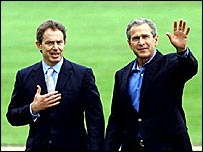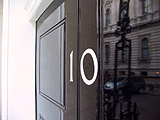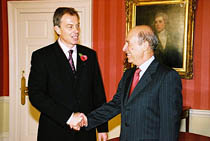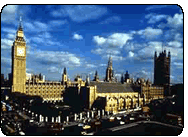| (insert your NIE or newspaper logo here) |
Weekly Online LessonOnline Lesson ArchiveGrade Level: 7-12
|
A Hot Spotlight On UK's No. 10
 British
Prime Minister Tony Blair has been getting grilled in the political
hot seat recently. On Thursday, August 28, 2003, for example, he testified
before his country's High Court as part of the investigation into the
death of a British scientist.
British
Prime Minister Tony Blair has been getting grilled in the political
hot seat recently. On Thursday, August 28, 2003, for example, he testified
before his country's High Court as part of the investigation into the
death of a British scientist.
The scientist, Dr. David Kelly, was an expert in Iraq's weapons of mass destruction (WMD) programs, and he has been at the center of allegations that the government exaggerated the case for war against Iraq. In July, Kelly committed suicide just a week after he was exposed by government officials as the source behind a British Broadcasting Corp. report. The news story alleged that Blair's staff had "sexed up" intelligence findings to make a stronger case for pre-emptive war against Iraq.
BBC's May 29 report jumpstarted the growing suspicion that the Prime Minister's government essentially lied to the public about the true threat posed by Saddam Hussein. In turn, some believe, Blair's credibility has affected that of U.S. President George W. Bush.
In his State of the Union address in January, President Bush made the case that the United States should wage war against Iraq, a country that, so far, had not directly threatened or attacked the American people. He told the public that, "The British government has learned that Saddam Hussein recently sought significant quantities of uranium from Africa." In essence, that provided proof that Hussein was building weapons of mass destruction. Now, evidence is arising that officials, perhaps both in the UK and the U.S., knew this statement was unsupportable in fact.
 Around
the time of Kelly's death in July, Blair became the fourth British prime
minister to address a joint meeting of Congress. Both he and Bush insisted
their decision to invade Iraq had been based on sound intelligence.
Around
the time of Kelly's death in July, Blair became the fourth British prime
minister to address a joint meeting of Congress. Both he and Bush insisted
their decision to invade Iraq had been based on sound intelligence.
Blair also told Congress that even if Britain and the U.S. had been wrong about weapons of mass destruction, history would forgive the removal of Saddam Hussein. "If we are wrong, we will have destroyed a threat that at its least is responsible for inhuman carnage and suffering," he said.
Although Blair is often seen as a political equal of Bush, the British government is setup differently than the American government. It's worth understanding the differences, as these nations and their leaders will continue to shape domestic and global policies, such as military spending, deployment of our forces, and relationships with allies.
So this week you'll be traveling to London, England, and pop by 10 Downing Street and the Palace of Westminster. We'll introduce you to the British Prime Minister and his government, along with the Houses of Parliament.
Number 10
 Our
first visit in London is with the British prime minister at 10
Downing Street. Let's begin in the Photo
Gallery, and see what A
Day in the Life of the Prime Minister (PM) is like. Click
Next to move through the PM's day with him.
Our
first visit in London is with the British prime minister at 10
Downing Street. Let's begin in the Photo
Gallery, and see what A
Day in the Life of the Prime Minister (PM) is like. Click
Next to move through the PM's day with him.
What types of people does the PM meet with during the course of a day? What other kinds of activities fill his schedule?
During his residency at Number 10, the Prime Minister enjoys more than just his office and the front stoop, which is mostly what we saw during his work day. So let's go take a Tour of the rooms. Read how the place became an official government residence, then walk through the rooms — soaking in their art and history — by going behind the discrete black door and starting with the Entrance Hall.
 Navigate
through the rest of the rooms using the Inside No. 10
navigation at the top right of the page. You can also click on bolded
names within the text to learn more about each historical figure, and
you can look around each room in a panoramic view if you have QuickTime
3 or higher installed.
Navigate
through the rest of the rooms using the Inside No. 10
navigation at the top right of the page. You can also click on bolded
names within the text to learn more about each historical figure, and
you can look around each room in a panoramic view if you have QuickTime
3 or higher installed.
Go on to discover more insights about the History of this property beginning with its earlier notoriety as the Island of Thorns. Then read about The First Houses on the Downing Street Site, the Creation of Downing Street, the early history of the house as residence of the First Lord of the Treasury, and browse the section on Downing Street in War.
Take some time to meet a few of the Prime Ministers in History, including Tony Blair, Margaret Thatcher, and Sir Winston Churchill, as well as one or more from the 18th and 19th centuries.
What role does the Prime Minister play in shaping the country and its relationships with other nations? How does the development of the building site reflect the history of London and Britain in general? How did political power shift between the Labour and Conservative parties over the years?
Parliament's Place
 While
learning about Number 10, you likely discovered that PM Tony Blair is
the leader of the Labour Party, which won more seats in Parliament's
House of Commons during the last General Election than the Conservative
Party. But how exactly does this two-party system work, and where do
the House of Lords, the Crown and the Prime Minister fit in?
While
learning about Number 10, you likely discovered that PM Tony Blair is
the leader of the Labour Party, which won more seats in Parliament's
House of Commons during the last General Election than the Conservative
Party. But how exactly does this two-party system work, and where do
the House of Lords, the Crown and the Prime Minister fit in?
Go eXplore Parliament to uncover the answers. Find out What Parliament Does, especially what roles the House of Commons and the House of Lords play in governing the United Kingdom. Also learn about the relationship between Parliament and Government, and how the Ministers are chosen and what Select Committees do.
How do Members of Parliament (MPs) and Peers hold seats in these two chambers? Who is the Opposition? How does the Prime Minister acquire his political position? What are some of the differences between the House of Commons and the House of Lords?
 Next,
explore the History
of Parliament, and read about Parliament and the
Monarchy and the Right to Vote.
Next,
explore the History
of Parliament, and read about Parliament and the
Monarchy and the Right to Vote.
When was the Bill of Rights passed, and how did it clarify the political power of the monarch and the Houses of Parliament?
Now visit the Explore Zone, and take a Tour of Parliament and uncover the palace's past by clicking on each room on the map. Test how much you've learned by playing the Political Puzzle, the Speakers Chair, and Who Am I? games.
How do Parliament's structure, traditions and rules allow debates to happen in an orderly and fair way? How does the UK's way of governing its country compare to that of the United States? For example, how does the U.S. Congress compare to the Houses of Parliament? What are some of the similarities and differences between the British PM and his Cabinet and the U.S. President and his Cabinet?
Newspaper Activities
In issues of Targetnewspaper find stories about the British Prime Minister or Parliament, particularly those related to events in Iraq or the UK's relationship with the U.S. Has anyone in Blair's Cabinet resigned recently? What has been happening with the investigation into scientist David Kelly's death? Has any new information been revealed about what the British and American governments had confirmed or exaggerated regarding Saddam Hussein and WMDs? How are the general public and the governing bodies, in the UK and in the U.S., responding to the latest news? Has the news seemed to change the relationship between President Bush and Prime Minister Blair or has it remained stable?
© Copyright 2003
Learners Online, Inc.
